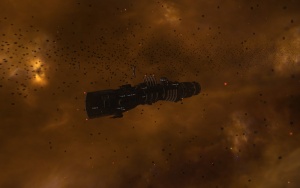
|
This wiki is closed in favour of the new wiki. Information shown is likely to be very out of date. |
Omicron-91
Error creating thumbnail: Unable to save thumbnail to destination
|
This page has been retired but kept for historical or other reasons, The information on this page may be incorrect, out of date or just not relevant to this version of Discovery. It should not be taken as canon nor any authority on the current version of Discovery. It is kept simply to show some history of the Discovery Mod:
See also:
|

|
A lot of these system pages are outdated, Space's nav map may be better. |
Omicron-91 is a Edge World system controlled by the Corsairs.
| [show]System navmap (FL, v4.88.1) (link) |
|---|
| [show]System navmap (FLC, v4.88.1) (link) |
|---|
System Overview
|
Local factions
Lawful
None known Semi-Lawful
None known Unlawful
|
Planets
Stations
|
Commodities
Produced
None known Mineable
|
Areas of Interest
Asteroid Fields
Calborana Field
The Calborana Field is a massive offshoot of the Walker Nebula surrounding Rheinland. Within its boundaries, it contains glowing rocks, heated by the unique properties of the dense dust inside the Calborana Field. Heat that goes in to the field rarely comes out, keeping the temperature a toasty two thousand degree centigrade. Once inside the field, any ships without strong hull plating start to soften and melt, often resulting in a cockpit blowout for those in fighter-sized craft. This is mistaken by most ship sensors as high levels of radiation.
Alexandria Station has no scanner records of any radiation from this cloud except the usual amounts of background interference. This asteroid field is responsible for the deaths of many of the explorers who ventured too far from Alexandria.
Incidentally, Alexandria also scanned a lone Titan flying into the asteroid field a few years ago. The fighter wouldn't respond to hails, nor did it indicated that it was an exploration vessel. This particular fighter hasn't been seen since.
Despite the heat, many artifacts have survived the eons that they've been trapped inside this baking field of rock and are available to mine. Only ships with hull plating resistant to heat can venture inside though, making artifact extraction unreliable.
Santa Marina Asteroid Field
The Santa Marina asteroid field is a dustless field whose asteroids are of low density but voluminous in nature. Alexandria Station, the first station to be constructed in Omnicron-91, lies within this field, conspicuously placed for the ease of navigation of freighters hauling construction materials.
The asteroid field is used primarily as a training ground for pilots permitted to be in the system. Many battles that the Corsairs have fought in the past have been inside asteroid fields, so pilots use the Santa Marina field to hone their combat skills for these situations.
Santa Marina itself contains no resources of any value, and is consequently not a target for further development by the Corsairs.
Battleships
Battleship Prox
Guarding the entrance to Omicron-91, the Prox was the first battleship to be commissioned by the Brotherhood. Having fought through many successful engagements across Sirius, it outlived its usefulness and was decommissioned in 812AS. The Prox was due for deconstruction in 813AS, but narrowly escaped its fate when the Brotherhood announced its intentions to develop the system fully. Given a partial overhaul on Tripoli, and a later refit at Rhodes, the Prox is now the fully functioning guardian for Omicron-91. All traffic that passes into and out of the system is cleared by the communications controllers on the Prox. Any unsuitable or unwanted vessels are turned away at this point, though many simply come to visit this famous battleship.
Onboard the Prox, there is an expanded power grid in place of the now empty engine bay. The weaponry has been overhauled and as a result, this battleship is quite lethal to any attackers or threats. For any Corsair visitors though, the Prox is a nice place to be. There is a museum deck for those wishing to learn about the Brotherhood and its organisational history, a restaurant serving food produced on Barcelona and there's even an arcade section for children.
On the one hand, the Prox is the gatekeeper for Omicron-91. On the other, it is a place for your average Corsair to relax. As such, the Prox is the only installation in the system that Corsairs are free to dock upon as they please.

Nebulae
Unquera Cloud
The Unquera cloud is a medium-sized offshoot of the Walker Nebula. The dust it contains within its boundaries has some scanner dampening properties, but the cloud itself is clear from any bodies of significant mass. There are trace deposits of rare elements such as Gold, Silver and Niobium in the cloud, but since it's all dust, it cannot be gathered with any speed. Efforts to extract these materials from the clouds have thus proven to be futile.
It is theorised that the Unquera cloud used to contain asteroids of sizeable mass, but they have long since disappeared, possibly draw in by the much larger Calborana asteroid field. It is unclear, however, why the dust did not follow the asteroids, if this theory is correct.
Many capital ships have been seen conducting weapons tests inside and around the cloud, leading those not in the know to ask questions about the exact location of Rhodes shipyard. Most think that Rhodes is located within this cloud, though they do not know where exactly the shipyard is. The Brotherhood refuses to disclose its location, but will neither confirm nor deny the presence of an installation in the Unquera cloud.
Jump Gates/Holes
| [show]Spoiler: Jump Hole/Gate Locations |
|---|




